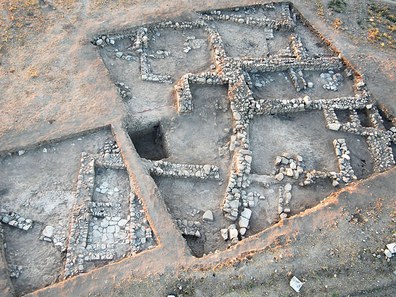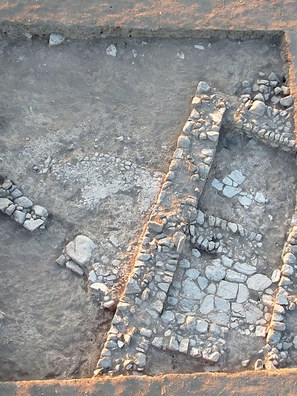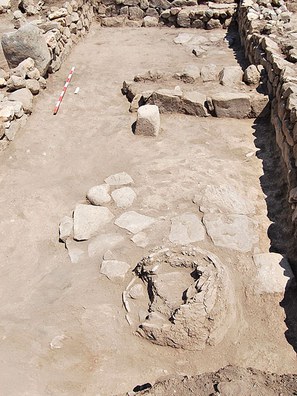
To begin with, let us turn briefly to the results from the small excavation on the top of the mound. Although this was a very small excavation (2 x 5 m trench), the results were extremely interesting. The dates for the establishment of the occupation on the mound itself have always been something of a puzzle to us. In earlier seasons, we indicated that there was a notable lack of fine ware on the mound itself, which meant that it was almost impossible to closely date this occupation. However, given the presence of datable fine ware on the terrace, as well as some parallel building techniques, it had long been our assumption that the origins of the settlement on the mound were parallel in date. Our excavations this summer suggest that this may not necessarily be the case. Although we will need to do further excavation to confirm our results from this season, we can now preliminarily state that it looks like the early Byzantine level on the mound may not have been as extensive as we previously believed. Excavation at the base of the wall in square 800.910, a trench that was opened originally in 2004, has exposed the base of the Byzantine wall, as well as the foundation trenches for this wall. The ceramics sequence in these foundation trenches is almost entirely Iron Age (with a minor amount of Hellenistic pottery), indicating that the Byzantine population seems to have flattened the mound in preparation for building, and then sunk their foundation trenches into the earlier levels. There is no evidence for early Byzantine pottery in the foundation trenches, at the base of the wall, or in the occupation levels associated with the fortification wall. In fact, on the west side of the wall—an area excavated in 2004 (800.900/810.900)—the soil was very sterile, suggesting that the mound was leveled off in preparation for use. This has led to a new set of questions, but it does seem likely that the fortification of the mound occurred during the Middle Byzantine revival of the ninth century. This is in keeping with some evidence for this period in Greece. See , "The Rural House in the Medieval Peloponnese: An Archaeological Reasessment of Byzantine Domestic Architecture," in Archaeology in Architecture: Studies in Honor of Cecil L. Striker, eds. J. J. Emerick and D. M. Deliyannis, (Mainz, 2005), 119–28.
Excavation on the terrace itself, our primary focus of excavation, has provided a far more nuanced view of the development of the site; we are extremely excited about the findings. The 2008 excavation season confirmed our initial observations concerning phasing, and raised some interesting questions about how Byzantine archaeologists perceive the Middle Byzantine population on the Anatolian Plateau. We began the season by opening a new trench—950.970—and extending 930.980. Both of these areas were chosen strategically. In the case of the first trench, we were hoping to catch the same stratigraphical flooring sequence that we caught in the 2004 season in 940.970, where we found a series of four sealed surfaces stretching from the early Byzantine through to the abandonment of the site at the end of the Middle Byzantine period. The 2004 excavations had been done in an area that had experienced some disturbance, and so we were hopeful that if we extended to the north we might get a more complete sequence. We were not disappointed.

Although there was some minor agricultural disturbance, which probably removed parts of the very last phase of occupation, we were excited to discover the wall foundations and flooring systems for the same structure visible in 940.970. However, the latest floor was much higher than those we found in the neighboring trench, confirming that we do have a more complete sequence of floors. In fact, what we found was a Middle Byzantine structure with two internal rooms, both of which contained a combination packed mud and flagstone floor. Outside of this structure we found the remains of a large plastered area. Although this find slowed us considerably, it does confirm that the Middle Byzantine phases are more extensive than we previously believed. Exact dating remains an issue, as there were no coins associated with the area. We did, however, find three small fragments of a red ware vessel with a Greek inscription, although there was not enough left to provide any information. This was an unusual find, not only because of the general lack of fine ware at the site, but also because of the inscription. Further analysis of these fragments may prove useful.
By far, our most significant finds came from trench 930.980, which was begun in 2006 and was extended to its full size in this excavation. The eastern side of the trench provided some extremely important phasing information, while the western side of the trench (in conjunction with the removal of the balk separating this trench from 930.970), provided evidence for a utility/cooking area in keeping with evidence from other sites for the Middle Byzantine period. The phasing in 930.980 proved to be more complicated than we had previously experienced, or indeed, expected. What became most evident in the excavations in this area was that until now our understanding of the phases of the middle Byzantine period has been oversimplified. In fact, we have at least two major phases for the middle Byzantine period. The earliest one is characterized by the reorganization of the early Byzantine structure. Rooms are subdivided and blocked up in this period; new functions are also applied to different chambers. However, although the manner of construction changes from plastered walls to walls mortared with mud, the early part of the Middle Byzantine phase is still characterized by well-formed and well-faced walls indicating the presence of some infrastructure and money. Our dates for this phase are still a point of discussion, since there is no fine ware and almost no coinage. The end of the Middle Byzantine period, on the other hand, is characterized by less structurally sound walls. Rooms are further subdivided, but walls are now constructed with no foundations and with loosely packed stones with no mortar. Thus, the decline that we have previously attested to the middle Byzantine period can be more closely identified with the end of this period and the subsequent abandonment of the site. Our recognition that the middle Byzantine is present in at least two phases (and given the number of floors, probably more sub phases) was due in part to a reexamination of both the evidence and our assumptions. The question of how we define the Middle Byzantine occupation of sites has become a talking point in Byzantine archaeology recently,Marica Cassis attended a symposium at Leiden in February 2007 entitled "Archaeology of the Countryside in Medieval Anatolia," where a lengthy discussion ensued about defining middle Byzantine domestic structures. Although we have considered them to exhibit decline from the Early Byzantine period, new theories—particularly emanating from the excavations at Sagalassos—suggest that change is perhaps a more appropriate term for understanding these structures. and it became clear to us that the complex that we are excavating is a particularly good example of understanding Middle Byzantium in terms of change as opposed to decline.

A case in point in this discussion was our discovery of an entire kitchen/utility area on the western side of 930.980 (and with the removal of the balk in 930.970). This room has, on its east, west, and north sides, walls that probably have early Byzantine wall foundations. At some point, probably at the start of the middle Byzantine period, the original doorway of the east wall was blocked with a large stone, and the doorway was placed almost certainly in the south. This room was then furnished with two workbenches, including one with a small seat, and two large hearth areas, one of which includes a large oven. The flooring system for this phase was a packed mud surface inset with flagstone areas in conjunction with the hearths. This area was almost certainly a utility/cooking area, and there is some interesting parallel evidence from a number of urban sites excavated on the coast of Asia Minor.See S. Eyice, "Observations on Byzantine Period Dwellings in Turkey," in Housing and Settlement in Anatolia: A Historical Perspective, ed. Y. Sey (Istanbul, 1996), 206–20; R. G. Ousterhout, "Secular Architecture," in The Glory of Byzantium, ed. H. C. Evans and W.D. Wixom (New York, 1997), 193–99; K. Rheidt, "City or Village? Housing and Settlement in Middle and Late Byzantine Anatolia," in Housing and Settlement in Anatolia: A Historical Perspective, ed. Y. Sey (Istanbul, 1996), 221–23; K. Rheidt, "Byzantinische Wohnhäuser des 11. bis 14. Jahrhunderts in Pergamon," Dumbarton Oaks Papers 44 (1990): 195–204; İ. Türkoğlu, "Byzantine Houses in Western Anatolia: An Architectural Approach," Al Masāq 16.1 (2004): 93–130.
It has been argued that domestic housing in the Middle Byzantine period became increasingly centered on a courtyard cooking area.This tendency is noted in Türkoğlu 2004: 108, who notes that one of the more characteristic changes of the middle Byzantine period is the use of the courtyard for both "cooking and crafts" and consequently as a primary living area. The structural evidence suggests this, as does the large number of artifacts that were found in this area. Among the finds in this area were several grinding stones, small utilitarian lamps, and a large number of metal artifacts (1, 2, and 3), all of which can be connected with horses, household chores, or cooking. For example, we found a horseshoe, part of a bridle, and an implement for cleaning the mud off of hooves. We also found a piece of saw, and some implements that are probably connected with cooking. This room was clearly a center of activity within the complex, which has added to our belief that what we have here is a large domestic complex, functioning either as an independent household or, more likely, as part of a larger village.
Beyond the excavation work, we had two further research goals for the 2008 season. One of these was to continue analysis of the pottery. With the help of an assistant, Marica Cassis was able to analyze a backlog of Byzantine pottery in order to continue compiling the shapes, forms, and fabrics visible at Çadır Höyük. We now have a much stronger sense of the ceramics at the site, and we will soon be able to offer a more complete analysis of the ceramics in our publications. This work allowed us to fulfill the final research goal for the season, which was the initial preparation of material for publication. We have now begun to prepare reports and publications on the Byzantine material excavated at Çadır Höyük to date. An initial report has been submitted to the Netherlands Institute for Near Eastern Archaeology to be published as part of the symposium proceedings from the 2007 conference on Medieval Anatolia, and this report contains information from the 2008 season. We are in the process of writing a popular article for Near Eastern Archaeology magazine, as well as a full-length excavation report encompassing material from the past seven years. New evidence from the 2008 season has also been presented at academic conferences, including the American Schools of Oriental Research.
In the following year, we will be dedicated to getting out the preliminary reports for the Byzantine excavations. However, the finds from the last year have also given us some further directions for research. The exposure of 950.970 gives us a good opportunity to trace and confirm all of the phases of occupation and hopefully to be able to date them more securely. The exposure of 930.980 has provided us with further evidence for the purpose of the site. By following this to the south and east, we will be able to further define whether this is a complex or a single family dwelling. Once we have a firm grip on this complex, we will also then be able to further explore the early Byzantine dwelling lying beneath it.